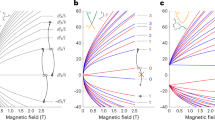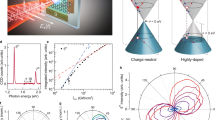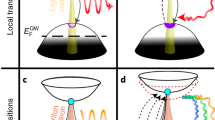Abstract
The Landau level laser was proposed long ago as a unique source of monochromatic radiation that would be widely tunable in the THz and infrared spectral ranges using a magnetic field. However, despite many efforts, this appealing concept never progressed to the design of a reliable device. This is because of the efficient Auger scattering of Landau-quantized electrons, an intrinsic non-radiative recombination channel that eventually gains over cyclotron emission in all materials studied so far (conventional semiconductors with parabolic bands, but also in graphene with massless electrons). Auger processes are favoured in these systems because the Landau levels (or their subsets) are equally spaced in energy. Here, we show that this scheme does not apply to massless Kane electrons in gapless HgCdTe, where undesirable Auger scattering is strongly suppressed and sizeable cyclotron emission is observed. The gapless HgCdTe thus appears as a material of choice for future Landau level lasers.
This is a preview of subscription content, access via your institution
Access options
Access Nature and 54 other Nature Portfolio journals
Get Nature+, our best-value online-access subscription
$29.99 / 30 days
cancel any time
Subscribe to this journal
Receive 12 print issues and online access
$209.00 per year
only $17.42 per issue
Buy this article
- Purchase on Springer Link
- Instant access to full article PDF
Prices may be subject to local taxes which are calculated during checkout




Similar content being viewed by others
Data availability
The data that support the plots within this paper and other findings of this study are available from the corresponding author upon reasonable request.
Code availability
The code for modelling of cyclotron mode energies is available from the corresponding author on reasonable request.
References
Cohen, M. L. Cyclotron resonance and quasiparticles. AIP Conf. Proc. 772, 3–6 (2005).
Lax, B. Cyclotron resonance and impurity levels in semiconductors. In Proc. Int. Symp. Quantum Electronics (ed. Townes, C. H.) 428 (Columbia University Press, 1960).
Gornik, E. in Narrow Gap Semiconductors. Physics and Applications Vol. 133 (ed. Zawadzki, W.) 160–175 (Lecture Notes in Physics, Springer, 1980).
Gornik, E. Far infrared light emitters and detectors. Physica B+C 127, 95–103 (1984).
Knap, W. et al. A far-infrared spectrometer based on cyclotron resonance emission sources. Rev. Sci. Instrum. 63, 3293–3297 (1992).
Maiman, T. H. Stimulated optical radiation in ruby. Nature 187, 493–494 (1960).
Wolff, P. A. Proposal for a cyclotron resonance maser in InSb. Phys. Physique Fizika 1, 147–157 (1964).
Wolff, P. A. Cyclotron resonance laser. US patent 3,265,977 (1966).
Aoki, H. Novel Landau level laser in the quantum Hall regime. Appl. Phys. Lett. 48, 559–560 (1986).
Morimoto, T., Hatsugai, Y. & Aoki, H. Cyclotron radiation and emission in graphene. Phys. Rev. B 78, 073406 (2008).
Sirtori, C. Applied physics—bridge for the terahertz gap. Nature 417, 132–133 (2002).
Tonouchi, M. Cutting-edge terahertz technology. Nat. Photon. 1, 97–105 (2007).
Gornik, E. et al. Landau-level-electron lifetimes in n-InSb. Phys. Rev. Lett. 40, 1151–1154 (1978).
Potemski, M. et al. Auger recombination within Landau levels in a two-dimensional electron gas. Phys. Rev. Lett. 66, 2239–2242 (1991).
Tsitsishvili, E. & Levinson, Y. Auger scattering between Landau levels in a two-dimensional electron gas. Phys. Rev. B 56, 6921–6930 (1997).
Schneider, J. Stimulated emission of radiation by relativistic electrons in a magnetic field. Phys. Rev. Lett. 2, 504–505 (1959).
Unterrainer, K. et al. Tunable cyclotron-resonance laser in germanium. Phys. Rev. Lett. 64, 2277–2280 (1990).
Blaser, S., Rochat, M., Beck, M., Hofstetter, D. & Faist, J. Terahertz intersubband emission in strong magnetic fields. Appl. Phys. Lett. 81, 67–69 (2002).
Jasnot, F. et al. Direct surface cyclotron resonance terahertz emission from a quantum cascade structure. Appl. Phys. Lett. 100, 102103 (2012).
Morimoto, T., Hatsugai, Y. & Aoki, H. Cyclotron radiation and emission in graphene—a possibility of Landau-level laser. J. Phys. Conf. Ser. 150, 022059 (2009).
Wendler, F. & Malic, E. Towards a tunable graphene-based Landau level laser in the terahertz regime. Sci. Rep. 5, 12646 (2015).
Wang, Y., Tokman, M. & Belyanin, A. Continuous-wave lasing between Landau levels in graphene. Phys. Rev. A 91, 033821 (2015).
Brem, S., Wendler, F. & Malic, E. Microscopic modeling of tunable graphene-based terahertz Landau-level lasers. Phys. Rev. B 96, 045427 (2017).
Cole, N. & Antonsen, T. M. Electron cyclotron resonance gain in the presence of collisions. IEEE Trans. Plasma Sci. 45, 2945–2954 (2017).
Brem, S., Wendler, F., Winnerl, S. & Malic, E. Electrically pumped graphene-based Landau-level laser. Phys. Rev. Mater. 2, 034002 (2018).
Plochocka, P. et al. Slowing hot-carrier relaxation in graphene using a magnetic field. Phys. Rev. B 80, 245415 (2009).
Mittendorff, M. et al. Carrier dynamics in Landau-quantized graphene featuring strong Auger scattering. Nat. Phys. 11, 75–81 (2015).
König-Otto, J. C. et al. Four-wave mixing in Landau-quantized graphene. Nano Lett. 17, 2184–2188 (2017).
Kane, E. O. Band structure of indium antimonide. J. Phys. Chem. Solids 1, 249–261 (1957).
Kacman, P. & Zawadzki, W. Spin magnetic moment and spin resonance of conduction electrons in α-Sn-type semiconductors. Phys. Status Solidi B 47, 629–642 (1971).
Orlita, M. et al. Observation of three-dimensional massless Kane fermions in a zinc-blende crystal. Nat. Phys. 10, 233–238 (2014).
Teppe, F. et al. Temperature-driven massless Kane fermions in HgCdTe crystals: verification of universal velocity and rest-mass description. Nat. Commun. 7, 12576 (2016).
Berestetskii, V. B., Lifshitz, E. M. & Pitaevskii, L. P. Relativistic Quantum Theory, Vol. 4, Part 1 (A Course of Theoretical Physics, Pergamon, 1971).
Weiler, M. in Semiconductors and Semimetals Vol. 16 (eds Willardson, R. & Beer, A. C.) Ch. 3, 119–191 (Elsevier, 1981).
Winnerl, S. et al. Carrier relaxation in epitaxial graphene photoexcited near the Dirac point. Phys. Rev. Lett. 107, 237401 (2011).
Goerbig, M. O. Electronic properties of graphene in a strong magnetic field. Rev. Mod. Phys. 83, 1193–1243 (2011).
Yavorskiy, D., Karpierz, K., Grynberg, M., Knap, W. & Lusakowski, J. Indium antimonide detector for spectral characterization of terahertz sources. J. Appl. Phys. 123, 064502 (2018).
Faist, J. et al. Quantum cascade laser. Science 264, 553–556 (1994).
Sirtori, C. GaAs quantum cascade lasers: fundamentals and performance. Collection de la Société Française d’Optique 7, 03 (2002).
Williams, B. S. Terahertz quantum-cascade lasers. Nat. Photon. 1, 517–525 (2007).
Saleh, B. E. A. & Teich, M. C. Fundamentals of Photonics 2nd edn (Wiley, 2007).
Acknowledgements
We acknowledge discussions with D. M. Basko and R. J. Nicholas. This work was supported by the ANR DIRAC3D project. The research was also partially supported by the CNRS through the LIA TeraMIR project, by the Occitanie region and MIPS Department of Montpellier University via the Terahertz Occitanie platform, and by the Foundation for Polish Science through the TEAM and IRA Programs financed by the EU within the SG OP Program. Part of this work has been supported by the project CALIPSO under the EC contract no. 312284. We are grateful to P. Michel and the FELBE team for their dedicated support.
Author information
Authors and Affiliations
Contributions
The experiment was proposed by M.O. and M.P. The sample was grown by N.N.M. and S.A.D. Time-resolved and continuous-wave magneto-optical experiments were carried out by M.O., M.M., S.W., C.F. and M.H. The cyclotron emission experiments were performed by D.B.B., C.C., F.T. and W.K. All co-authors discussed the experimental data and interpretation of the results. M.O. and M.P. wrote the manuscript and all co-authors commented on it.
Corresponding author
Ethics declarations
Competing interests
The authors declare no competing interests.
Additional information
Publisher’s note: Springer Nature remains neutral with regard to jurisdictional claims in published maps and institutional affiliations.
Supplementary information
Supplementary Information
Supplementary discussion, Figs. 1–3 and refs. 1–8.
Rights and permissions
About this article
Cite this article
But, D.B., Mittendorff, M., Consejo, C. et al. Suppressed Auger scattering and tunable light emission of Landau-quantized massless Kane electrons. Nat. Photonics 13, 783–787 (2019). https://doi.org/10.1038/s41566-019-0496-1
Received:
Accepted:
Published:
Issue Date:
DOI: https://doi.org/10.1038/s41566-019-0496-1
This article is cited by
-
Terahertz cyclotron emission from two-dimensional Dirac fermions
Nature Photonics (2023)
-
Strong second-harmonic generation by sublattice polarization in non-uniformly strained monolayer graphene
Nature Communications (2023)
-
Landau level laser
Nature Photonics (2021)
-
Pseudo-magnetic field-induced slow carrier dynamics in periodically strained graphene
Nature Communications (2021)
-
Impact Ionization Induced by Terahertz Radiation in HgTe Quantum Wells of Critical Thickness
Journal of Infrared, Millimeter, and Terahertz Waves (2020)



